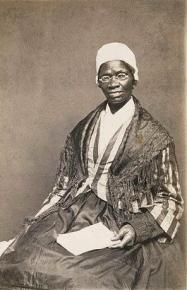Following the path of struggle
looks at the tradition of women's struggle for equality and liberation.
IN AN interview some years ago pegged to International Women's Day, which takes place on March 8, singer Chrissie Hynde mentioned Mary Wollstonecraft as one of her heroines.
If it's possible to point to a single founder of the modern movement for women's liberation, it's Wollstonecraft. She was a philosopher, novelist, poet and political activist, and wild and free.
In 1792, she produced A Vindication of the Rights of Women, complementing and responding to Paine's Rights of Man, published the previous year. She wrote:
How many women thus waste life away, the prey of discontent, who might have practiced as physicians, regulated a farm, managed a shop and stood erect, supported by their own industry, instead of hanging their heads surcharged with the dew of sensibility, that consumes the beauty to which, at first, it gave luster.
Sojourner Truth knew the feeling. She'd been born a slave in New York in 1797, the year that Wollstonecraft died. She fought from the age of 11 for abolition and women's rights. Her speech in September 1851, at a Women's Rights Convention in Akron, Ohio, still rings down through the years:

That man over there says that women need to be helped into carriages, and lifted over ditches, and to have the best place everywhere. Nobody ever helps me into carriages, or over mud puddles, or gives me any best place! And ain't I a woman? Look at me! Look at my arm! I have ploughed and planted, and gathered into barns, and no man could head me! And ain't I a woman?
I could work as much and eat as much as a man--when I could get it--and bear the lash as well! And ain't I a woman? I have borne 13 children, and seen most all sold off to slavery, and when I cried out with my mother's grief, none but Jesus heard me! And ain't I a woman?
Six years later, on March 8, 1857, the slogan "Ain't I A Woman" was carried on placards by women textile workers in Sojourner's home state of New York, protesting against low wages and inhumane working conditions.
NEW YORK women marched, 15,000-strong, again on March 8, in 1908, demanding shorter work hours, better pay, voting rights and an end to child labor. They summed up their demands as "Bread and Roses." The march and the slogan were to inspire a poem by James Oppenheim, published in The Atlantic three years later.
And the poem, somewhat adapted, became the marching song of women garment workers in Lawrence, Massachusetts, the year after that, when they came out for higher wages and union rights in a strike which united dozens of immigrant communities under the leadership of the Industrial Workers of the World.
As we come marching, marching in the beauty of the day,
A million darkened kitchens, a thousand mill lofts gray,
Are touched with all the radiance that a sudden sun discloses,
As the people hear us singing: Bread and roses! Bread and roses!...
As we come marching, marching, unnumbered women dead
Go crying through our singing their ancient cry for bread.
Small art and love and beauty their drudging spirits knew.
Yes, it is bread we fight for, but we fight for roses, too!...
Our lives shall not be sweated from birth until life closes;
Hearts starve as well as bodies: Bread and roses! Bread and roses!
One of the IWW organizers in Lawrence was 21-year-old Elizabeth Gurley Flynn. At a fundraiser for the strikers, she declared:
The queen of the parlor has nothing in common with the maid in the kitchen; the wife of a department store owner shows no sisterly concern for the 17-year-old girl who finds prostitution the only door open to a $5-a-week wage clerk. The sisterhood of women, like the brotherhood of men, is a hollow sham to labor. Behind all its smug hypocrisy and sickly sentimentality are the sinister outlines of the class war.
Exactly 100 years after Soujourner Truth's speech, in 1951, also in Akron, Ohio, Chrissie Hynde was born.
She attended Kent State University, and was an antiwar activist and close friend of Jeffrey Miller. One of the iconic photographs of the age shows another student kneeling over Miller's body, gunned down by a National Guardsman while protesting the invasion of Cambodia.
Hynde's band, the Pretenders, included her song for Jeffrey Miller, "Revolution," on their 1994 album Last of the Independents:
The fond fear of danger,
That's what sets us apart,
Couldn't wait for the real world
To test the strength of the lion's heart...
When we watch the children play,
Remember how the privileged classes grew.
And from this day, we set out
To undo what won't undo.
Looking for the grand in the minute.
Every breath justifies
Every step that we take to remove what the powers that be can't prove
And the children will understand why.
I want to die for something.
Bring on the revolution,
Don't want to die for nothing.
Bring on the revolution,
I want to die for something.
There's the connection between Mary Wollstonecraft and Chrissie Hynde. It's the tradition coming down, the river ever-flowing, the women marching, marching.
First published in the Belfast Telegraph.


